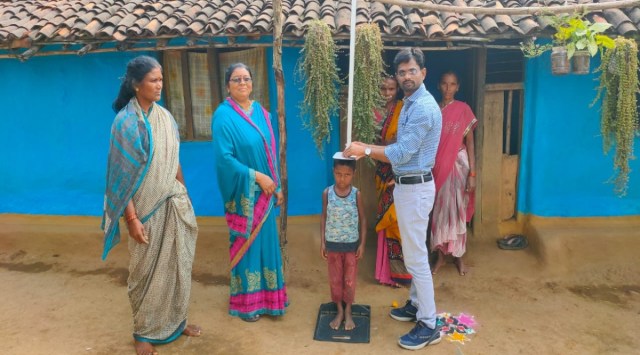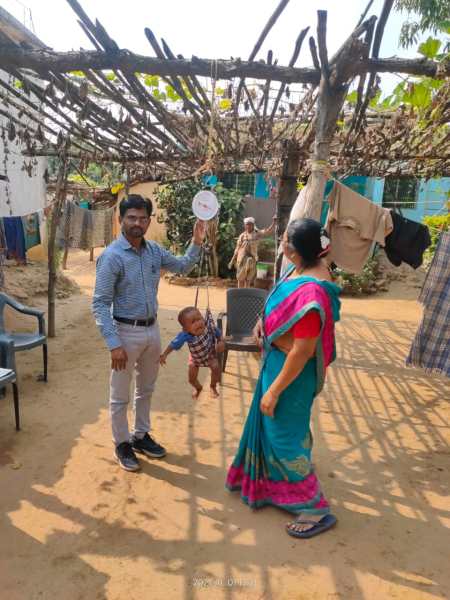- India
- International
With khichdi, tiranga paratha and sesame laddu, Gadchiroli’s severe malnourishment cases drop by 50%
Last October, Gadchiroli introduced a special diet programme for malnourished children between the ages of six months and six years, and since then 3,794 malnourished children (of the 7,111 listed) have recovered in the district.
 Gadchiroli, a tribal-dominated district in Maharashtra has set a national example in the fight against malnutrition.
Gadchiroli, a tribal-dominated district in Maharashtra has set a national example in the fight against malnutrition.Last September, when a frail Vrushabh Usande, 3, was suspended from a scale, he weighed only 10 kg. Ideally, a boy his age should weigh between 11-17 kg. Like many other children in Gurnoli village in Kurkheda Tehsil of Gadchiroli district in Maharashtra, he was listed in the Moderate Acute Malnutrition (MAM) category and enrolled in a special diet programme.
Six months later, he weighed 11 kg and he was released from the MAM programme. While the one-kilogram increase in his weight was small, his farmer parents noticed how gradually Vrushabh’s gaunt face began to look more fuller and rounder. “Earlier, his cheek and collar bones were visible. Now, he looks healthy and fresh,” said Sawaswati Rajesh Usande, Vrushabh’s mother.
Gadchiroli, a tribal-dominated district in Maharashtra has set a national example in the fight against malnutrition. Last October, the district introduced a special diet programme for malnourished children between the ages of six months and six years, and since then 3,794 malnourished children (of the 7,111 listed) have recovered in the district.
Of the 1,017 children identified as Severely Acute Malnourished (SAM), 513 (50.14%) recovered, and among the 6,094 MAM children, 3,281 (52.83%) have been released from the programme after six months. Also, of the 2,141 Severely Under-weight (SUW) children, 789 or 27 per cent gained weight and recovered.

After Nandurbar, Gadchiroli district has the second highest number of malnutrition cases among children in Maharashtra.
“We screened over 1.1 lakh children in the district and enrolled malnourished and underweight ones in the programme,” said Kumar Ashirwad, Chief Executive Officer (CEO) of the district. “For the first time, such a diet chart was introduced in any district in Maharashtra. The same diet can be implemented across the state to improve the health of children,” he added.

Malnutrition refers to deficiencies, excesses, or imbalances in a person’s intake of energy and/or nutrients, as per the World Health Organisation (WHO). “Children with malnutrition have weaker immune systems, leaving them vulnerable to developmental delays, disease and death,” said Dr Ravikant Singh, founder of the Doctors for You NGO. Maharashtra has the highest number of malnourished children in India.
 CEO Ashirwad and the state’s ICDS department, in consultation with nutritionists, listed eight nutrient-dense Maharashtrian recipes to help the children in their recovery.
CEO Ashirwad and the state’s ICDS department, in consultation with nutritionists, listed eight nutrient-dense Maharashtrian recipes to help the children in their recovery.
After Nandurbar, Gadchiroli district has the second highest number of malnutrition cases among children in Maharashtra. Under the centralised Integrated Child Development Services (ICDS) programme, the malnourished children are provided with energy dense nutritious food (EDNF) – a ready-made paste with micro-nutrients to ensure that the children gain normal weight. However, during the Covid-19 pandemic, the scheme was stopped and the Women and Child Development (WCD) department started providing Take Home Ration (THR), which included packages containing 2 kg each of rice, wheat, dal and chana, apart from cooking oil, salt and spices.
However, the ration was often consumed by the entire household and not just the affected child. So, CEO Ashirwad and the state’s ICDS department, in consultation with nutritionists, listed eight nutrient-dense Maharashtrian recipes to help the children in their recovery.
These included vegetable khichdi (cooked with rice and husked split moong lentils), sprouts cutlet, peanut cutlet, tiranga paratha (made with wheat flour, beet root, spinach and soybean flour), a dry chutney made with curry leaves, Mutthe (a cutlet made of rice, green gram and drumstick leaves), groundnut, jaggery, and sesame laddu and kadi patta shankarpali (a snack made of curry leaves).
“So, along with the THR, we also introduced this special diet. These eight recipes provide iron, calcium, protein, vitamins, and energy,” said Kumar. “We gave the recipes to the anganwadi workers and also trained them in the preparation. For the last six months, they have been cooking it at the anganwadi centres and serving it hot to the malnourished children,” he added.
Most of the vegetables for the programme was grown by the anganwadi workers in the anganwadi mini kitchen. The department also gives Rs 100 to each malnourished child in the programme. The entire scheme is being funded by gram panchayats.
“This meal is served in the afternoon. To avoid the repetition of the same meals, we plan it in advance… The parents are also happy because for the last two years the children were dependent only on THR,” said Archana Ingole.
While Covid-19 restrictions were lifted in the state on April 2, anganwadi centres haven’t opened yet, and so the enlisted children are weighed by anganwadi workers every month during the door-to-door survey.
Apr 24: Latest News
- 01
- 02
- 03
- 04
- 05



































